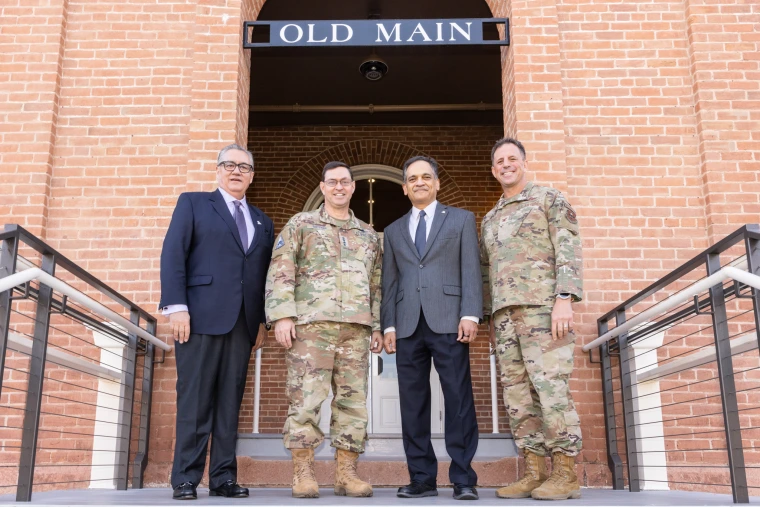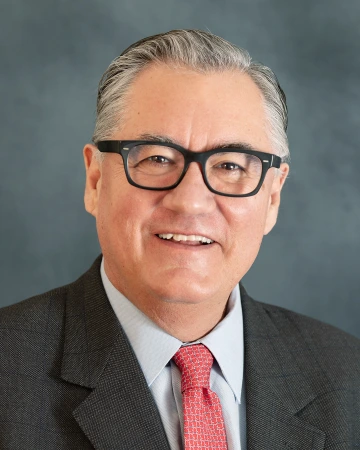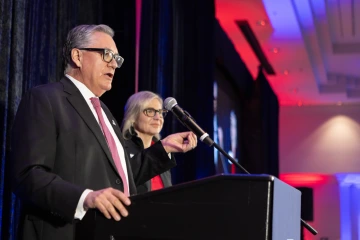Potential Energy
Meet new Senior Vice President of Research Tomás Díaz de la Rubia.

Saltzman, chief of space operations, United States Space Force; Suresh Garimella, University of Arizona president; Col. Cory Christoffer, detachment commander, U of A Air Force ROTC.
Chris Richards
Tomás Díaz de la Rubia says there were two things a kid growing up in northern Spain couldn’t escape. One was soccer. Football. “It was everywhere,” he says. The other was Formula 1 racing — exotic to American audiences, but second nature to Europeans.
It was the racing that hooked him: these sleek machines, whipping around the track at 200 miles an hour. “Look, Formula 1 is about risk,” he says. “It’s about being on the leading edge. I think that idea that you have to be on the leading edge to win has always been very attractive to me.”
The product of a family of scientists and engineers, he knew from a young age that he’d go into what he calls “a STEM discipline.” “When I was around 12 or so, my parents got me a subscription to a magazine called Investigación y Ciencia, which is a translation of Scientific American,” he says. “I just became fascinated by science and physics and so on. One thing led to another.”
After starting college in Spain, he first came to the States to study at the University at Albany in upstate New York. “I came with the idea that I was going to spend a year. That was 43 years ago. Never went back.”

Tomás Díaz de la Rubia
More than half of those 43 years were spent at the Lawrence Livermore National Laboratory in Livermore, California, where Díaz de la Rubia landed as a postdoc working on developments toward fusion energy — a preoccupation that sticks with him today.
“Livermore had — still today, has — the biggest, fastest computers on the planet,” he says. “They made me an offer I couldn’t refuse: I had access to these big computers.” He had found his cars. Now the senior vice president of research and innovation at the University of Arizona, Díaz de la Rubia is charged with martialing the considerable brainpower of the U of A toward solving what he calls the “grand challenges of the future.”
Take fusion. “Fusion is the source that powers the stars,” he says. “Everything in the universe happens up in the stars. All the energy that we get on Earth comes from the sun. So, if you can mimic and replicate the power of fusion here on Earth, you’ve transformed the way we think about energy in the future.”
A beautiful image, something out of a children’s book, really. The reality is trickier. “We have been trying for decades to conquer fusion on Earth,” he says. “It’s very hard.” In 2022 came a breakthrough, at — of all places — Díaz de la Rubia’s old employer, Livermore.
“They were able to compress a hydrogen gas to 100 million degrees Kelvin and 100 billion atmospheres of pressure,” he says. “They crashed this gas into this very hot, very high-pressure spot, and these isotopes of hydrogen — these hydrogen atoms — fused together. They overcame the repulsion between two equally charged particles. When that happens, Einstein showed us that the light-changing mass of the outgoing products is transformed into energy. That’s the energy of fusion.” They were able to replicate, on a very small scale, the sun.
Now, let’s say they’re able to do it again (and Díaz de la Rubia says “it’s not an if, it’s a when”). Where would a place like the U of A fit in? First, there’s the technological aspect. “We want to be the university developing the materials, the lasers, the engineering technologies to take that scientific breakthrough that happened in a laboratory in California and turn it into a commercial source of power,” he says.
This would also mean building partnerships with the private sector and business community, making ourselves indispensable to the economic advancement of the state. “[The other day] I was giving a speech about our vision for the future to a company that is thinking about siting their manufacturing facilities here in Tucson,” he says. “I told them: Think of the University of Arizona as a place with open doors for you. We want to be your partner.”
This is a familiar refrain. But there is a finer point. “If you think about the energy market over the next 20, 30 years; if you think about energy demand not just from data centers but from global growth; if you think about the billion people that don’t have access to energy today, and you think about that demand, and you think about all of the power plants that are aging and need to be replaced over the next 20, 30 years — it’s a multi-trillion dollar market globally, right?” he says. To be able to contribute to what’s coming, we have to think about it now. We have to be able to see the horizon.

Díaz de la Rubia and Jennifer Barton, director of the U of A’s BIO5 Institute, speaking at the February Fuel Wonder event in Phoenix.
Chris Richards
Then there’s the question of culture. A year ago, Díaz de la Rubia asked a group of political scientists and sociologists to survey people about their responses to the concepts of “nuclear power” and “fusion.” With “nuclear,” it was: “It’s dirty, it’s dangerous.” You talk about building a nuclear power plant in someone’s backyard and people get upset. Now, fusion is technically nuclear power. “But fusion is clean,” he says. “There are no greenhouse gas emissions. No high-level radioactive waste. It’s safe.” In a webinar about a new U of A research competition called the Big Idea Challenge, Díaz de la Rubia joked that a mechanical engineer, a chemical engineer and an electrical engineer don’t make a transdisciplinary team. Facing the challenges he imagines facing isn’t just about building things, it’s about changing minds and shaping ideas. About using the social and behavioral sciences to bring the public into a conversation. We will not meet the future with STEM alone.
Fusion is one example. Díaz de la Rubia also talks about combining our research in AI into our work in health care, and combining our work in space — in particular, satellite monitoring — with our work in defense and national security. (“Space is a very, very busy place these days,” he says.) These are not new initiatives on their own. But in seeing across disciplines and thinking more flexibly about how we can apply our expertise, Díaz de la Rubia imagines a kind of multiplicative effect: not just two familiar projects, but a new project entirely.
“We’re a billion-dollar university in research — one of only roughly 30 in the country out of 1,500,” he says. “That’s a unique club to be part of.” Díaz de la Rubia would like to double that number to two billion. “To do that, you cannot simply ask the same faculty to write more proposals and work harder,” he says. The answer will probably be somewhere we haven’t yet been.
We come back to Formula 1. “There’s a lot of technology that comes out of the developmental aspect of Formula 1, because they’re really on the leading edge, on the frontiers,” he says. “You think about how those technologies developed in Formula 1 eventually get into our cars.”
There is an analogy to his work at Livermore here. The military gets all this great technology before it enters the market. Formula 1 is the proving ground for what might eventually end up in our cars. Work done in small, confined places that ends up making a positive impact on society in general and leaves behind a legacy for future generations. Díaz de la Rubia has spent more than 40 years in labs and universities. And this whole time, he’s been thinking about the world.
